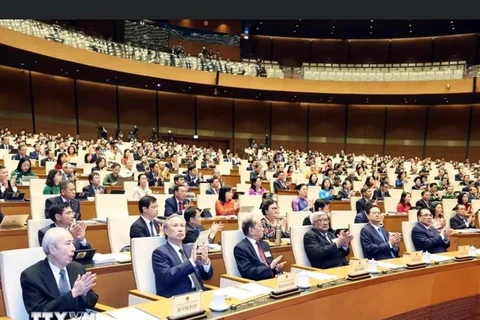
Hanoi (VNA) - Vietnam aims for an ambitious economic growth rate of 6.8%-7% in 2024, a target that requires concerted efforts by government bodies, businesses, and society, Nguyen Thi Huong, General Director of the General Statistics Office (GSO) said at a press briefing on the country’s socio-economic performance for the third quarter and first nine months of 2024.
Vietnam recorded a GDP growth rate of 6.82% in the first nine months of 2024. Amidst global economic uncertainties—rising inflation, geopolitical tensions, and climate-related disasters—this growth reflects resilience and adaptability, Huong said.
Key contributors to the growth included controlled inflation, robust manufacturing, vibrant export activities, and a recovering tourism sector. Investments from both domestic and foreign sources also grew, while social welfare programmes and disaster relief efforts played a vital role in maintaining stability.
“Achieving this growth showcases Vietnam’s proactive adjustments to global economic fluctuations and effective management of natural disasters,” said Huong.
However, the road ahead is fraught with challenges. Economic risks persist globally, compounded by domestic issues such as lingering impacts from natural disasters, disease outbreaks, and inflationary pressures. Furthermore, key industries are yet to fully recover, and the competitiveness of small and medium enterprises remains a concern.

“The fourth quarter is critical. To achieve the set target, we need joint efforts of the entire society, close coordination among government agencies and localities, and proactive and innovative actions of the business community,” Huong emphasized.
To achieve its growth objectives, the GSO recommends six key solutions, which can be considered firm pillars for sustainable economic growth.

First, maintaining macro-economic stability is foundational, Huong said, noting the need to keep stable exchange rate, control inflation, and ensure major economic balances. She went on to say that vigilant monitoring of essential goods prices, ensuring of supply and avoidance of price hikes for state-regulated goods and services in post-disaster times will safeguard economic stability.
Promoting domestic consumption is the second solution, with more trade promotion activities, development of e-commerce, and support for disaster-affected households and businesses among priorities. Strengthening the domestic market will reinforce economic resilience.
The third solution is to promote exports, which is one of the key growth drivers, through leveraging international trade agreements and diversifying export markets. Removing obstacles for export activities and helping businesses adapt to new import regulations will facilitate growth in this sector.
Fourth, fast-tracking public investment projects, especially in transportation infrastructure, and attracting high-quality foreign direct investment (FDI) are key. The government needs to issue policies to attract technology transfer projects that integrate domestic enterprises into global supply chains.
Fifth, disater forecasting should be enhanced in the face of the constant threat of natural disaters as a consequence of climate change. Adaptation strategies are needed for agricultural production. Concurrently, suitable social welfare policies to address the needs of disaster-stricken communities are also a top priority.

And finally, improving public administration efficiency and transparency, and fostering a fair business environment are the key to the success of the above mentioned measures. The government should also push forwar with digital transformation and administrative reforms.
The GSO will collaborate with State agencies and local authorities to help businesses access resources, information and policies, with priority given to access to credit, markets, technology and high-quality human resources, Huong concluded./.






















